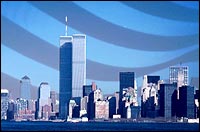|
|
 |
|
. . . . .
. . . . .
. . . . .
. . . . .
. . . . .
| |||||||||||||||||
|
|
||||||||||||||||||
|
Home Daily Almanac American Indians World United States History & Gov't Biography Sports Entertainment Business Society & Culture Health & Science Weather Homework Center Fact Monster Sources: Atlas Almanacs Encyclopedia Dictionary E-mail this page Get FactFinder: free reference center for your desktop Newsletter |
World Trade Center History
Magnificent buildings graced skyline
The twin towers of the World Trade Center were more than just buildings.
They were proof of New York's belief in itself. Built at a time when New York's future was cloudy, the towers restored confidence and stopped the decline of lower Manhattan.
Brash, glitzy, and grand, they quickly became symbols of New York.
Controversial Beginnings The towers were not always popular. A world trade center was first proposed
in 1960 by the Downtown-Lower Manhattan Development Association to
revitalize seedy "radio row," dominated by electronic stores. Chase
Manhattan Bank Chairman David Rockefeller, founder of the development
association, and his brother, Nelson, New York governor,
pushed hard for the project, insisting it would benefit the entire city.
In 1962, the Port Authority of New York and New Jersey began plans to build the center. Minoru Yamasaki and Associates of Michigan, and Emery Roth & Sons, P.C., were hired as architects. Eventually, Yamasaki decided on two huge towers. Critics charged that a modern monolith would rob New York of character, ruin the skyline, disrupt television reception, and strain city services. Massive Buildings However, the project was approved and construction began in 1965. Five
streets were closed off and 164 buildings demolished to create the 16-acre
site. Construction required the excavation of more than 1.2 million cubic
yards of earth which created 23.5 acres of land along the Hudson River, now Battery City Park, a
complex of four 60-story skyscrapers and four apartment buildings.
Building the World Trade Center took 200,000 tons of steel, 425,000 cubic yards of concrete, 600,000 square feet of glass, and 12,000 miles of electric cables. During peak construction periods, 3,500 people worked at the site. A total of 10,000 people worked on the towers; 60 died during its construction.
Instant Landmarks The towers were dedicated in 1973. They were the world's tallest buildings
for only a short time, since the Sears Tower in Chicago
was dedicated a month later. However, the north tower sported a 360-foot television mast that allowed it to technically remain the world's tallest building. A hotel, a shopping
plaza, and three smaller buildings nearby completed the complex.
The twin towers became the most popular postcard image in the world. Some three dozen movies were made at the towers, including the 1976 remake of King Kong. Thousands of Visitors The buildings weighed more than 1.5 million tons and contained 198 miles of heating ducts and 23,000 fluorescent light bulbs. Each of the towers had 110 floors, and each floor was roughly 50,000 square feet large. Shopping malls with restaurants,
stores, and barbershops dotted the concourses. The mall underneath the
towers contained another 75 stores. The six basements also included two New
York subway stations and the PATH trains to New Jersey used by 150,000
people daily.
Some 50,000 people worked in the buildings, while another 200,000 visited or passed through each day. The top floor observation deck had 26,000 visitors daily, who could see for 45 miles on a clear day. From the ground, the towers were visible for at least 20 miles. The 43,600 windows were washed automatically, while the air conditioning system was the world's largest, with 60,000 tons of cooling capacity. It took 250,000 cans of paint each year to spruce up the towers. Each tower had 97 elevators for passengers and six for freight. Express elevators zoomed skyward at 27 feet per second, reaching the top in 4.8 minutes. More than 300 computer main frames in the towers served the towers' occupants. International Glamour Most of the nearly 300 tenants were blue-chip firms enjoying the prestige of
one of the world's most glamorous business addresses. Eight law firms, six
banks, five stock brokerage houses, and three insurance companies had their
headquarters in the twin towers. A number of foreign firms, such as the Bank
of Yokohama, also had offices there. The complex had its own zip code,
10048.
Publicity Seekers Attracted Before their collapse, 19 murders were committed and 17 babies born in the
towers. They also contained nine chapels representing six different faiths.
As the towers became more famous, they attracted daredevils. Three men parachuted from the top, while one dozen mountain climbers scaled the outside. In 1974 a Frenchman walked a tightrope between the towers. Previous Bombing In 1993, terrorists drove a truck packed with 1,100 pounds of explosives
into the basement parking garage at the World Trade Center. Despite the size
of the blast, only six
people were killed and 1,000 injured. After that bombing, the number of
parking spaces in the basement garage was reduced from 1,000 to 600.
Security in the buildings was considerable. The lobby in each building had 12 X-ray machines and 16 concierge desks. The towers employed over 300 security personnel, used 300 security cameras, and featured 828 emergency doors. Buried Treasure The basements of the World Trade Center also contained vast vaults used by
the COMEX metals trading division of the New York Mercantile Exchange. Some
3,800 gold bars, weighing
12 tons and worth more than $100 million, lie buried under the mountains of
rubble left after the attack. Authorities say the gold has never been safer.

Rebuilding Plans In 1999, New York businessman Larry Silverstein purchased the World Trade
Center's 99-year lease on the twin towers for $3.2 billion from the Port
Authority of New York and New Jersey. Since the attack, Silverstein has
vowed to rebuild, suggesting that four smaller towers is a possibility.
|
|||||||||||||||||
|
||||||||||||||||||